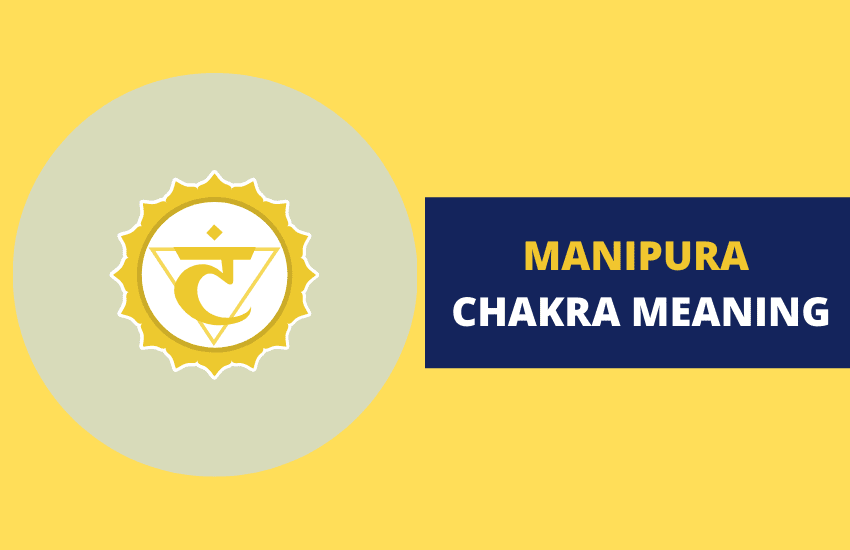
Table of Contents
The Manipura is the third primary chakra, located above the navel. The word Manipura in Sanskrit means city of jewels, resplendent, or lustrous gem. The Manipura chakra governs the pancreas and the digestive system, and aids in breaking down energy and transferring nutrients to the rest of the body.
The Manipura chakra is yellow, and its corresponding animal is the ram. It’s associated with the element of fire and is known as the Sun Centre. Due to its connection with fire, the Manipura represents the power of transformation. In tantric traditions, the Manipura is referred to as Dashachchada, Dashadala Padma, or Nabhipadma.
The Design of the Manipura
The Manipura chakra has dark colored petals on its outer ring. These ten petals are etched with the Sanskrit symbols: ḍaṁ, ḍhaṁ, ṇaṁ, taṁ, thaṁ, daṁ, dhaṁ, naṁ, paṁ, and phaṁ. The petals represent the ten Prānas or energy vibrations. While five of these petals are called Prāna Vayus, the others are termed Upa Prānas. Together, the ten pranas stimulate growth and development in the body.
In the middle of the Manipura chakra, there’s a red triangle that points downwards. This triangle is governed and ruled by the red-skinned and four-armed deity, Vahni. Vahini holds a rosary and a spear in his arms, and is seated on a ram.
The mantra or sacred syllable of the Manipura chakra is ram. Recitation of this mantra absolves an individual from illness and disease. Above the ram mantra, there’s a dot or bindu, within which the deity Rudra, a three-eyed deity, with a silver beard, resides. He’s seated on a tiger skin or a bull, and appears to grant boons and thwart fears.
Rudra’s Shakti, or female counterpart, is the goddess Lakini. She’s a dark-skinned deity who carries a thunderbolt along with a bow and arrow. Goddess Lakini is seated on a red lotus.
Role of the Manipura
The Manipura chakra is the gateway to astral and spiritual powers. It also supplies the body with cosmic energy, obtained from the digestion of food. The Manipura chakra provides individuals with strength and dynamism in their day-to-day activities.
When the Manipura’s strong and active, it enables good mental and physical health. People who have a balanced Manipura chakra, are more prone to making confident and wise decisions.
An active Manipura chakra can also enhance immunity and prevent illnesses. It purifies the body from negative energy, while simultaneously feeding positive energy to the organs.
Hindu philosophers and yoga practitioners deduce that mere intuition and instinctive emotions can lead to irrational behavior. Therefore, the Manipura chakra must work along with the Agya chakra, to instigate decisions that are both rational and righteous.
The Manipura chakra’s also associated with sight and movement. Meditating upon the Manipura chakra, can grant one the power to preserve, transform, or destroy the world.
Activating the Manipura chakra
The Manipura chakra can be activated through various yogic and meditative postures. The boat pose or the Paripurna Navasana stretches the stomach muscles and strengthens the abdomen. This particular pose activates the Manipura chakra and enables quicker digestion and metabolism.
Likewise, the bow pose or Dhanurasana stimulates the stomach organs. The bow pose can aid in the reduction of belly fat, and it helps keep the stomach region healthy and fit.
The Manipura chakra can also be activated by doing pranayama, that is, deep inhalation and exhalation routines. While breathing, the practitioner must feel their stomach muscles contract and expand.
Factors that Hinder the Manipura Chakra
The Manipura chakra can be blocked by impure thoughts and emotions. Blockages in the Manipura chakra can lead to digestive disorders and diabetes. It can also lead to nutrition deficiency and stomach problems such as ulcers and the irritable bowel syndrome.
Those who have an imbalanced Manipur chakra, can display aggressive and controlling behavior. They can also feel a lack of confidence to stand up for themselves and make appropriate decisions.
The Associated Chakra for The Manipura
The Manipura chakra’s in close proximation with the Surya chakra. The Surya chakra absorbs energy from the sun, and transfers it to the rest of the body, in the form of heat. The Surya chakra also aids in the process of digestion.
The Manipura Chakra in Other Traditions
The Manipura chakra has been an important part of several other practices and traditions in different cultures. Some of them will be explored below.
Qigong Practices
In Chinese Qigong practices, there are various furnaces that help transfer energy to the body. One of the major furnaces is present in the stomach, and converts sexual energy into a purer form.
Pagan Beliefs
In pagan beliefs, the region of the Manipura chakra’s very important for physical health. Its imbalance can lead to severe illnesses and disease. Pagan beliefs suggest breathing exercises to stimulate and activate the Manipura chakra. They also reiterate the importance of positive thinking.
Neo-pagan
In neo- pagan traditions, the practitioner imagines energy filling and flooding the naval region. During this process, a greater source of energy gets concentrated around the stomach, and it helps increase positive feelings. The practitioner can also stimulate energy through self-talk and affirmations.
Western Occultists
Western occultists associate the Manipura chakra with the process of breaking down energy. The role of the Manipura chakra is to create an equilibrium and transfer energy to various organs.
Sufi Traditions
In Sufi practices, the navel’s the chief center for energy production, and is the major source of nutrients for the entire lower body.
In Brief
The Manipura chakra plays an important role in the production and transmission of energy. Without the Manipura chakra, organs won’t be able to get their required minerals and nutrients. It also helps in keeping an individual happy, fit, and healthy.








